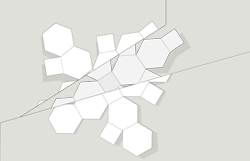

Technical
 |
 Technical |
| Overview | "The Shape of Discourse" uses the processing IDE to create dual graphical interfaces. These interfaces are based on a data set which is the result of an internet bot . One of the interfaces displays a three dimensional architectural structure that dynamically changeds over time; the other interface gives a two dimensional network representation of how the data is interpreted to create the structures that are being displayed. | |
| processing | Processing is an open project started by Ben Fry and Casey Reas at MIT and UCLA. Processing is a programming environment built on top of Java that allows for sophisticated graphical design via relatively simple Java code. "The Shape of Discourse" uses processing to create both the three dimensional structures and the two-dimensional network; processing was chosen because of the projects dependence on graphics. | |
| Spidering | This project relies on creating a cohesive/current-day discourse between different architects that shape our modern world. To this effect, a bot was created in processing to scour the internet looking for relationships between architects. The bot is seeded with 64 historically significant architects; by automatically accessing a search engine (Alta-Vista was used because it lacked anti-spidering software) the bot enters in every combination of architect pairs. This results in a set of webpages containing both names inclusively. By enumerating the number of “hits” each query produces allows for the quantification of a relationship between two architects. Thus the queries with more hits leads to a stronger relationship between architects while the queries with fewer hits leads to a weaker relationship. These results are put into a matrix of all the architects, and this data is passed to the three-dimensional processing program. | |
| Architectural Structure | The architectural structure code contains three main parts. The first part is code to build one truncated octahedron (toh). The toh is the primative brick that constitutes the three dimensional structure. Each toh has six squares and eight hexagons. Thus it has 24 vertices, 34 edges, and 14 sides. Therefore the code has three functions to deal with the creation of the toh: makePoints(), makeEdges(), and makeFaces(). All of these together make a single toh. The second part of the code is to implement an algorithm. This will be explained later in the Algorithm section. The third part of the code is the interface. The actual structure is limited to a box with a horizontal plane in the middle to simulate a three-dimensional grid. No toh can extend outside this box. Each toh represents a different architect; the initial camera orientation places the user behind a clear vertical plane that acts as a screen. Names of architects that represent the most recently created tohs are projected on this screen with the recent ones being dark and older ones faded. Using the mouse in the display window, the user can move the camera orientation to view the box/structure from any orientation. | |
| Algoritim | After the bot returns a matrix of numbers relating the architects, this algorithm is used to create the three dimensional structures. A first architect is picked at random. This architect is represented by a toh at the origin. For each side of this toh, an architect is chosen using the bot results. The 14 architects that relate most closely to the current architect get designated to each side of this toh (toh has 14 sides). Thus the related architects that have the highest relationship number to the current architect as determined by the bot get chosen. A weighted random function is used to pick a side of the toh. This function is weighted in proportion to the relationship number. The sides with the closer relationships get picked more often. The side/related architect that gets picked spawns another toh, out of that side, connected to the first toh. This toh represents the architect that the side was designated to. The algorithm starts over with the new toh. The total toh’s are set to some maximum number. After they are all drawn, the next toh is obtained by moving the very first toh to get a snake like effect. If the future position of a toh is already occupied by another toh, the weighted random function is run again until a vacant side is chosen. | |
| Network Display | The network display shows the history of our "discourse" displayed by the three dimensional architectural structure. The network display consists of a square grid of 64 points. Each point represents an architect. For each toh created by the architectural display, the related dot is highlighted. Then 14 lines are drawn from the highlighted dot to 14 different related architects on the grid based on the bot data. A colored line is drawn between the current architect and the chosen architect while the other 13 lines fade away. By following the colored lines one can follow the path of architect interaction being displayed by the architectural structure. Over a longer duration the dark lines fade away. | |